Related Research Articles

A tuning fork is an acoustic resonator in the form of a two-pronged fork with the prongs (tines) formed from a U-shaped bar of elastic metal. It resonates at a specific constant pitch when set vibrating by striking it against a surface or with an object, and emits a pure musical tone once the high overtones fade out. A tuning fork's pitch depends on the length and mass of the two prongs. They are traditional sources of standard pitch for tuning musical instruments.

Surgery is a medical specialty that uses manual and/or instrumental techniques to physically reach into a subject's body in order to investigate or treat pathological conditions such as a disease or injury, to alter bodily functions, to improve appearance, or to remove/replace unwanted tissues or foreign bodies. The subject receiving the surgery is typically a person, but can also be a non-human animal.

Laparoscopy is an operation performed in the abdomen or pelvis using small incisions with the aid of a camera. The laparoscope aids diagnosis or therapeutic interventions with a few small cuts in the abdomen.
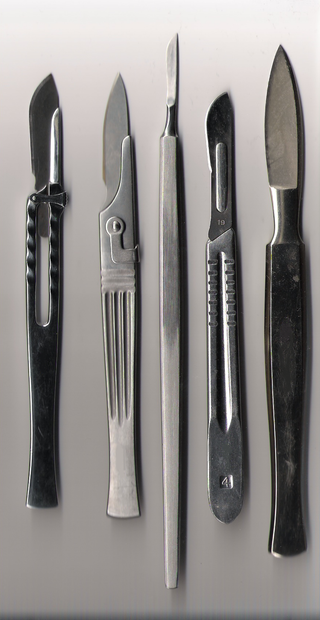
A scalpel, lancet, or bistoury is a small and extremely sharp bladed instrument used for surgery, anatomical dissection, podiatry and various handicrafts. A lancet is a double-edged scalpel.
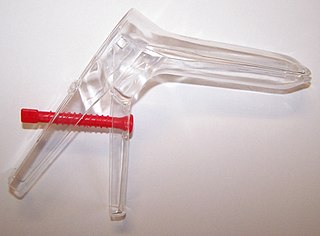
A speculum is a medical tool for investigating body orifices, with a form dependent on the orifice for which it is designed. In old texts, the speculum may also be referred to as a diopter or dioptra. Like an endoscope, a speculum allows a view inside the body; endoscopes, however, tend to have optics while a speculum is intended for direct vision.

Abū al-Qāsim Khalaf ibn al-'Abbās al-Zahrāwī al-Ansari, popularly known as al-Zahrawi (الزهراوي), Latinised as Albucasis or Abulcasis, was a physician, surgeon and chemist from al-Andalus. He is considered one of the greatest surgeons of the Middle Ages.
In ancient Greece, a hecatomb was a sacrifice of 100 cattle to the Greek gods. In practice, as few as 12 could make up a hecatomb.
Self-surgery is the act of performing a surgical procedure on oneself. It can be an act taken in extreme circumstances out of necessity, an attempt to avoid embarrassment, legal action, or financial costs, or a rare manifestation of a psychological disorder.

The Kitāb al-Taṣrīf, known in English as The Method of Medicine, is a 30-volume Arabic encyclopedia on medicine and surgery, written near the year 1000 by Abu al-Qasim al-Zahrawi (Abulcasis). It is available in translation. The Kitab al-Tasrif took al-Zahrawi over 50 years to complete. It contains information about a wide variety of illnesses, injuries, medical conditions, treatments, and surgical procedures. It describes over 200 different surgical instruments. Surgeons continued to rely on the Kitab al-Tasrif well into the 1700s.

A surgical instrument is a medical device for performing specific actions or carrying out desired effects during a surgery or operation, such as modifying biological tissue, or to provide access for viewing it. Over time, many different kinds of surgical instruments and tools have been invented. Some surgical instruments are designed for general use in all sorts of surgeries, while others are designed for only certain specialties or specific procedures.
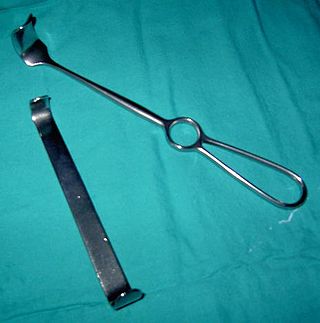
A retractor is a surgical instrument used to separate the edges of a surgical incision/wound or to hold away certain organs and tissues so that body parts underneath may be accessed during surgical operations.

Robot-assisted surgery or robotic surgery are any types of surgical procedures that are performed using robotic systems. Robotically assisted surgery was developed to try to overcome the limitations of pre-existing minimally-invasive surgical procedures and to enhance the capabilities of surgeons performing open surgery.
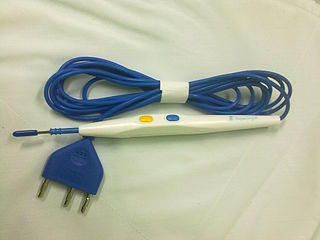
There are many different surgical specialties, some of which require very specific kinds of surgical instruments to perform.

Dental instruments are tools that dental professionals use to provide dental treatment. They include tools to examine, manipulate, treat, restore, and remove teeth and surrounding oral structures.
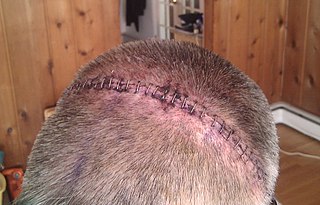
Surgical staples are specialized staples used in surgery in place of sutures to close skin wounds or connect or remove parts of the bowels or lungs. The use of staples over sutures reduces the local inflammatory response, width of the wound, and time it takes to close.
Single-port laparoscopy (SPL) is a recently developed technique in laparoscopic surgery. It is a minimally invasive surgical procedure in which the surgeon operates almost exclusively through a single entry point, typically the patient's navel. Unlike a traditional multi-port laparoscopic approach, SPL leaves only a single small scar.
A rib spreader, also known as Finochietto retractor, is a type of retractor specifically designed to separate ribs in thoracic surgery. Rack-and-pinion-type stainless steel rib spreaders were an innovation introduced by French surgeon Theodore Truffier in 1914. This was modified in 1936 by Argentinian surgeon Enrique Finochietto to have fenestrated blades and a hand-cranked lever to both separate the arms in a staged fashion and lock them in place at each stop. The Burford–Finochietto rib spreader has replaceable blades. The Tuffier and especially the Burford–Finochietto are ubiquitous in open thoracic surgery. Recently, a new intelligent, automated rib spreader in development demonstrated results superior to the Finochietto-style retractors.
Perioperative nursing is a nursing specialty that works with patients who are having operative or other invasive procedures. Perioperative nurses work closely with surgeons, anaesthesiologists, nurse anaesthetists, surgical technologists, and nurse practitioners. They perform preoperative, intraoperative, and postoperative care primarily in the operating theatre.
Senn is a term for the chief herdsman tending an Alp. As a surname:

Ancient Roman surgical practices developed from Greek techniques. Roman surgeons and doctors usually learned through apprenticeships or studying. Ancient Roman doctors such as Galen and Celsus described Roman surgical techniques in their medical literature, such as De Medicina. These methods encompassed modern oral surgery, cosmetic surgery, sutures, ligatures, amputations, tonsillectomies, mastectomies, cataract surgeries, lithotomies, hernia repair, gynecology, neurosurgery, and others. Surgery was a rare practice, as it was dangerous and often had fatal results. To perform these procedures, they used tools such as specula, catheters, enemas, bone levers, osteotomes, phlebotomes, probes, curettes, bone drills, bone forceps, cupping vessels, knives, scalpels, scissors, and spathas.
References
- ↑ Clifton G. Meals, BA, Roy A. Meals, MD (2007). "A History of Surgery in the Instrument Tray: Eponymous Tools Used in Hand Surgery". Journal of Hand Surgery. 32 (7): 942–953. doi:10.1016/j.jhsa.2007.05.007. PMID 17826545.
{{cite journal}}: CS1 maint: multiple names: authors list (link)